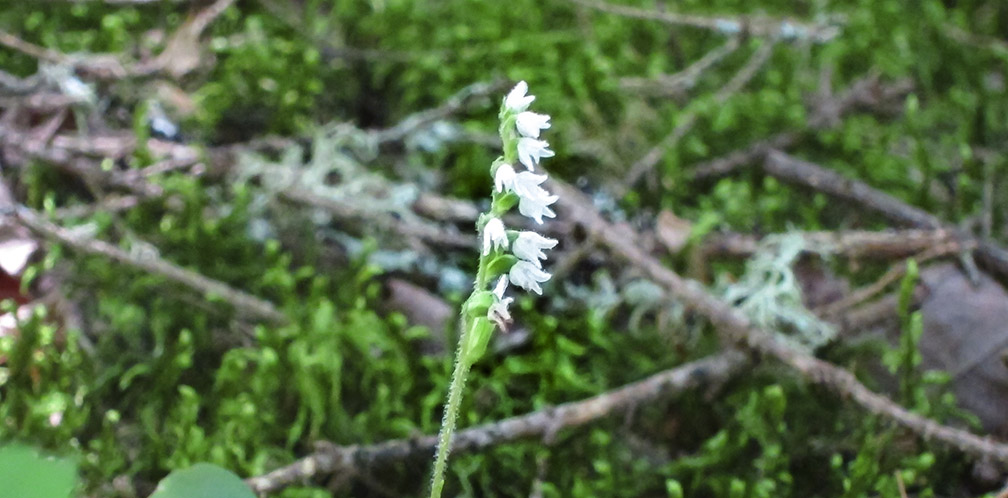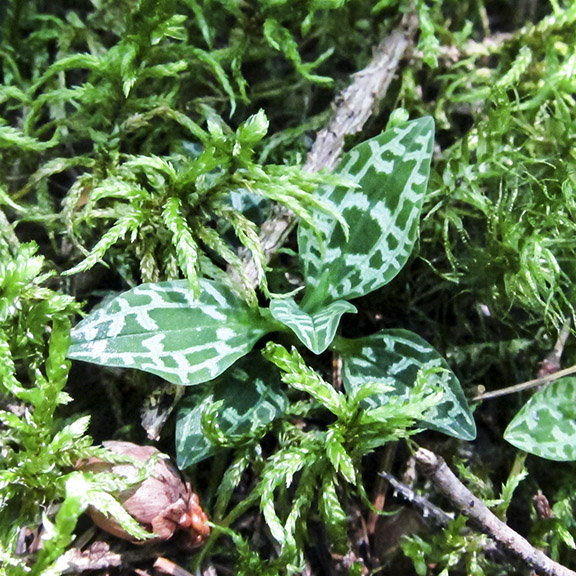Wildflowers of the Adirondacks:
Dwarf Rattlesnake Plantain (Goodyera repens)

Dwarf Rattlesnake Plantain (Goodyera repens) is a low-growing wildflower which produces a spike-like cluster of small white flowers in summer. It grows in shady, moist coniferous or mixed woods forests in the Adirondack Mountains of upstate New York. Dwarf Rattlesnake Plantain is a member of the Orchid family.
This plant is also known as Lesser Rattlesnake Plantain, Creeping Rattlesnake Plantain, Northern Rattlesnake Plantain, and Creeping Lady's Tresses. The scientific name is a reference to John Goodyer, a 17th century British botanist. The word repens means "creeping," in Latin.
Dwarf Rattlesnake Plantain is listed as endangered in Maryland and Massachusetts, exploitably vulnerable in New York State, and a plant of special concern in Connecticut and Tennessee.
Identification of Dwarf Rattlesnake Plantain

Dwarf Rattlesnake Plantain, as the name implies, is a small plant, generally growing only four to six inches tall. The stem is usually hairy.
Dwarf Rattlesnake Plantain is evergreen. The leaves are dark blue-green and oval to oblong, with a blunt point at the tip. The leaves are 1/2 to 1.25 inches long and are usually marked with prominent white or pale green netting.
This species produces small white flowers, which grow mostly on one side of a spike. The six-parted flowers are less than a quarter of an inch long and sometimes spiral the stalk. They are pollinated mainly by bumblebees. In the Adirondack region, Dwarf Rattlesnake Plantain begins blooming in late July or early August.
Uses of Dwarf Rattlesnake Plantain
Although the plant is not edible, it has been used for medicinal purposes. For instance, the Cherokee reportedly used Rattlesnake Plantain as a blood tonic, burn dressing, and cold remedy. Other native Americans are said to have used the roots and leaves for stomach diseases.
Wildlife Value of Dwarf Rattlesnake Plantain
Dwarf Rattlesnake Plantain has no apparent value as a wildlife food or cover.
Distribution of Dwarf Rattlesnake Plantain
Dwarf Rattlesnake Plantain occurs in Alaska, Yukon, and Newfoundland. In the eastern United States, its southern range reaches North Carolina and Tennessee. In the West, it occurs in disjunct populations in Arizona, New Mexico, and Colorado.
In New York State, Dwarf Rattlesnake Plantain is found in around half of the counties in the eastern half of the state. It is present in all counties within the Adirondack Park Blue Line, except Oneida, Lewis, Saratoga, and Washington counties.
Habitat of Dwarf Rattlesnake Plantain
Dwarf Rattlesnake Plantain tolerates a range of soil moistures, from well-drained to imperfectly drained soils. This plant grows in shade or part shade. It prefers thin acidic soils. Dwarf Rattlesnake Plantain is usually characterized as a mid- or late-successional species, generally occurring in stands more than seventy years old.
Dwarf Rattlesnake Plantain can be found in conifer or mixed wood forests. It has also been found in bogs and swamps, generally on humus-covered ground. It is not frequently found, but it can be seen along the upland portions of the Boreal Life Trail at the Paul Smiths VIC, where it grows on mossy, deeply shaded sites under conifers. It can also be seen growing in profusion along the Sucker Brook Trail at the Adirondack Interpretive Center.
References
Michael Kudish. Adirondack Upland Flora: An Ecological Perspective (The Chauncy Press, 1992), p. 235.
Michael Kudish. Paul Smiths Flora II: Additional Vascular Plants; Bryophytes (Mosses and Liverworts); Soils and Vegetation; Local Forest History (Paul Smith's College, 1981), p. 3
New York Flora Association. New York Flora Atlas. Dwarf Rattlesnake-plantain. Goodyera repens (L.) R. Br. Retrieved 27 March 2017.
United States Department of Agriculture. The Plants Database. Lesser Rattlesnake Plantain. Goodyera repens (L.) R. Br. Retrieved 27 March 2017.
United States Department of Agriculture. Fire Effects Information System (FEIS). Species Reviews. Goodyera repens. Retrieved 27 March 2017.
United States Department of Agriculture. US Forest Service. Descriptions of plant communities and site characteristics in areas where lesser rattlesnake plantain (Goodyera repens) typically occurs. Retrieved 27 March 2017.
Flora of North America. Goodyera repens (Linnaeus). Retrieved 27 March 2017.
NatureServe Explorer. Online Encyclopedia of Life. Dwarf Rattlesnake-plantain. Goodyera repens - (L.) R. Br. ex Ait. f. Retrieved 27 March 2017.
New York State. Adirondack Park Agency. Preliminary List of Species Native Within the Adirondack Park Listed Alphabetically by Scientific Name and Sorted by Habit. Volume 1. Updated 10.23.2006, p. 23. Retrieved 26 January 2017.
University of Wisconsin. Flora of Wisconsin. Goodyera repens (L.) R.Br. Retrieved 27 March 2017.
Minnesota Wildflowers. Goodyera repens (Lesser Rattlesnake Plantain). Retrieved 27 March 2017.
Lady Bird Johnson Wildflower Center. Goodyera repens. Retrieved 27 March 2017.
Plants for a Future. Goodyera repens - (L.) R.Br. Retrieved 27 March 2017.
University of Michigan. Native American Ethnobotany. A Database of Foods, Drugs, Dyes and Fibers of Native American Peoples, Derived from Plants. Lesser Rattlesnake Plantain. Goodyera repens (L.) R. Br. ex Ait. f. Retrieved 27 March 2017.
Allen J. Coombes. Dictionary of Plant Names (Timber Press, 1994), p. 82.
P.M. Eckel. A Grammatical Dictionary of Botanical Latin. Repens. (Missouri Botanical Garden, 2011).
Lawrence Newcomb. Newcomb's Wildflower Guide (Little Brown and Company, 1977), pp. 24-25.
Roger Tory Peterson and Margaret McKenny. A Field Guide to Wildflowers. Northeastern and North-central North America (Houghton Mifflin Company, 1968) pp. 18-19.
National Audubon Society. Field Guide to Wildflowers. Eastern Region. (Alfred A. Knopf, 2001), pp. 659.
William K. Chapman. Orchids of the Northeast. A Field Guide. (Syracuse University Press, 1997), pp. 60-61.
Charles H. Peck. Plants of North Elba. (Bulletin of the New York State Museum, Volume 6, Number 28, June 1899), p. 129. Retrieved 22 February 2017.
